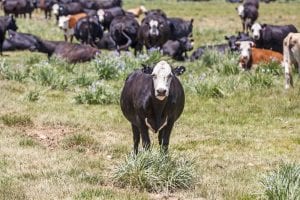A team of ten researchers looked closely at cattle grazing in California and determined that the practice has a great deal of potential in combatting catastrophic wildfires. Cattle are exceptionally efficient at reducing the amount of fine fuels that may be present that present hazards for wildfire if left unattended. The team first set out to understand how many cattle were in California and what their current consumption rate was.
“In 2017 there were 1.8 million beef cattle grazing rangelands across California. Those 1.8 million beef cattle were consuming about 11.6 billion pounds of fuel in 2017. So, it’s quite a large amount of fuel or forage that cattle are consuming across our state,” said Devii Rao, Cooperative Extension Livestock and Natural Resources Advisor serving San Benito, Monterey, and Santa Cruz counties. “I think what this research gets us to really think about is how can we use grazing as a targeted tool to improve public safety and in many situations improve our grassland habitat conservation goals.”
The research project, ‘Benefits of Cattle Grazing for Reducing Fire Fuels and Fire Hazard,’ was made possible through a grant from the California Cattle Council. The team used information from 2017 because it was the most current and comprehensive dataset available. Cattle grazing takes place in every county across the state aside from San Francisco. Cattle consume different levels of forage or fine fuels depending on the region. Rao explained that averaging for all regions across the state showed that cattle were consuming approximately 600 pounds of forage per acre. “Meaning they’re reducing almost 600 pounds per acre of fine fuels across our state on average,” Rao noted.
The research project highlights the value that cattle grazing can have for reducing fire fuels. Rao hopes that it will cause ranchers to start thinking more crucially about incorporating fuel reduction goals into grazing management plans. There is also an opportunity to increase grazing in high-fuel areas in and around the wildland-urban interface.
“I think there’s really a win-win-win opportunity here,” said Rao. “That triple win would be increasing fuel reduction and improving safety. In many situations, by grazing, we can actually achieve grassland habitat conservation goals. That third win would be increasing the financial sustainability of ranching by expanding the number of opportunities for ranchers to graze.”











